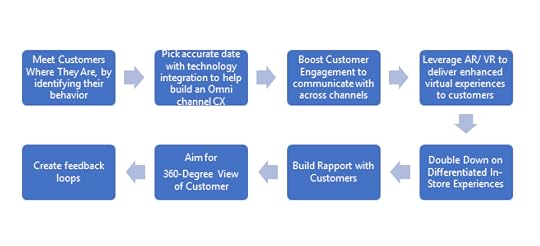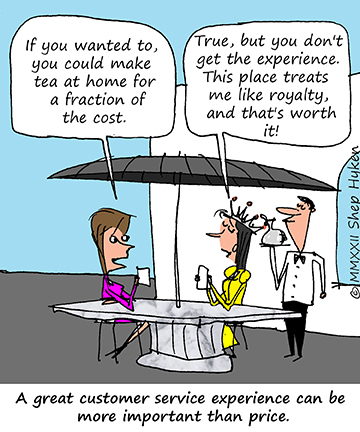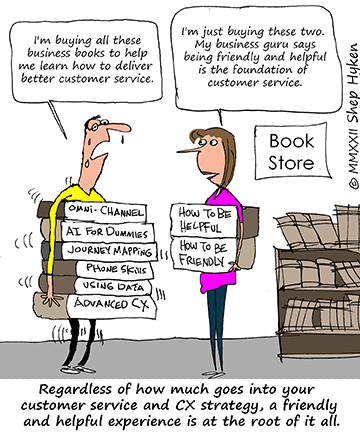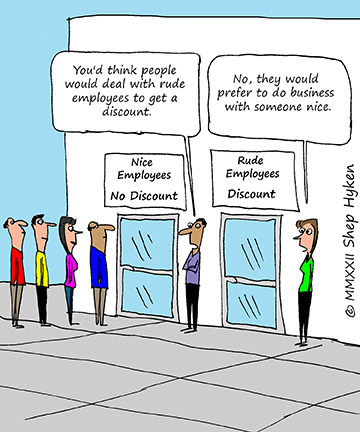Shep Hyken's Blog, page 66
April 8, 2022
Guest Post: Understanding Digital Customer Experience in Retail Industry
This week, we feature an article by Nikhil Pereira is a Contact Center expert with 20 years of end-to-end contact center expertise. He has experience across the Contact Center spanning Hiring, Training, Quality, Workforce Management, and Performance Management. He shares how retailers can understand the digital customer experience in the retail world.
Did you know that 70% of consumers have stopped doing business with a brand following a poor customer experience? Yes, that’s true! Now, the question that arises in this digital dominant world is how retailers can understand the digital customer experience requirements.
An experience through the customer’s buying journey is quite crucial and must be addressed by the retailers. Let’s look at some of the important factors which retailers must consider:
Understanding the customer’s needIt is not only about the product or service, which channel, and in what frequency or time of the year a customer is buying. It is also about the reasons behind buying the product such as the need it fulfills, the price the customer is ready to pay, or the promotions which motivate him to fulfill the need. It helps in the identification of the right products for the targeted consumer segment.
Product discovery experienceChoice overload is a real problem. Retailers need to provide contextual recommendations that have tangible benefits and advantages in simple language to make the right product purchase decision.
Product experienceRight information (QR code based in the physical stores), or how the customer experiences the product (closer to touch & feel) with information, digital 3D/AR renderings in the digital space goes a long way in the consumer buying process.
Product buying experienceSeamless cross-channel interactions, consistent pricing, product availability at the right source, a personalized promotion at the point of purchase, through easy purchase and payment process in the digital channel and App enabled guided store walk-through, promos at POP and queue-less, self-checkouts in the physical stores.
Brand care experienceA personalized approach to customer issues, consultative product advisories based on customer needs, and brand advocacy make the post-purchase brand experience special.
Retailers must understand that customers do not see digital channels the same way as they do. They easily bounce from one advanced channel to another as a portion of their overall customer involvement. To rise to the top in retail customer experience and make an advanced customer interface, you wish to make customized encounters that resound over all your digital media. This is often termed an omnichannel approach. Research shows that brands with the strongest omnichannel client engagement techniques hold 89% of their customers, in comparison to 33% of customers held by companies with powerless techniques. An omnichannel computerized client benefit methodology will empower you to meet your customers’ desires for ease, comfort, and speed over various computerized channels. This is influencing retail brands to look for Digital Customer Experience (DCX) solutions that take care of their customer and offer seamless customer experience across the popular channel.
Colossal Shift in the Retail IndustryAs per the Salesforce study, 82% of retailers are focused on improving customer experience. There is a critical need to develop a 360-degree view of the customer. As per Shopping Index, 71% of retailers are looking to invest in mobile apps over the next 2 years.
IDC analysts predict by 2024, 30% of Fortune 2000 companies will harness customer, product & inventory data to deploy the next best action that drives customer demand. 75% of retailers will fully integrate order and inventory data to optimize fulfillment. This will improve conversion by 10%, customer satisfaction by 50%, and reduce the cost to serve by 25%.
IDC researchers further state that within 2 years, 40% of the top 500 retailers will use AI-enabled decision-support to drive omnichannel retail KPIs, including Customer Lifetime Value (CLV), productivity, and profitability. Gartner analysts predict that by 2027, a quarter of Fortune 20 companies will be displaced by companies that neuromine and influence subconscious consumer behavior at scale.
Imperatives for New Age RetailRetailers must keep up with consumer demands for new channels, faster service, and a more seamless experience. The increasing exposure to — and use of — digital channels is driving these expectations for more connected, personalized, convenient, and timely retail experiences. Additionally, they need a more strategic and comprehensive approach to how they offer omnichannel engagement in the cloud, how they elevate customers between channels, and how they manage the customer data across all channels.
 Contemporary Retail CX Strategy’s
Contemporary Retail CX Strategy’s Sharing some hacks to better understand, gain and retain digital customer experience in the retail industry:
Develop better listeners and encourage storytelling Balance the real and virtual buying experience, through a channel-agnostic, seamless experience with in-store digitization Encourage social media engagement and sharing of in-store purchase Encourage and support online and offline communities Engage customers in DIY, product-building, and self-customization activities during the purchase 3 Advantages of Retail CX Strategy Retail Industry Leaders Game to Sustain Digital Customer Experience
Retail Industry Leaders Game to Sustain Digital Customer Experience The renowned names in the retail sector – Amazon, Walmart, M&S, and IKEA have identified the nerve and tapped the apt platforms to define the future of CX in retail. Let’s have a look at how.
The world’s largest retailer, Amazon has Go Stores with no cashiers or checkout lines. Therein, sensors in the shopping carts automatically scan items placed in the cart, and shoppers’ accounts are charged as they leave the store. Established retail chains here and abroad are now incorporating this approach. Besides, Amazon One is another “just walk out” payment technology wherein shoppers can pay by scanning their hands via biometrics. This feature is active in some Whole Foods locations.
Did you know, that another retail giant – Walmart collects about 2.5 petabytes of unstructured data from 1 million customers every hour. By implementing the “internet of things” sensors across over 2,200 trailers to give real-time information around the quality and freshness of its deliveries, it is also currently accelerating its digitization to create “smarter stores”, with shelf scanners to monitor product volumes, robotics, and computer vision cameras to increase efficiency and contactless payment to reduce customer effort & friction.
A leading British retailer, M&S, brings quality, great value food, clothing, and homeware to millions of customers across the globe. With the goal to personalize each of the billions of interactions across the website, mobile app, email, and social media, Marks & Spencer’s core pillar is a commitment to turbocharging growth on M&S.com. Underlying its digital strategy is a push to personalize M&S’s digital shopping experience for M&S customers across two of its largest online categories, clothing, and home, with the help of Adobe Analytics and Adobe Target.
IKEA, one of the global home furnishing brands based out of Sweden continues to improve its customer experience, especially in the digital space. With the introduction of Augmented Reality (AR) apps, shoppers can virtually place orders for furniture. Did you know, IKEA has also acquired Task Rabbit – an online platform that connects consumers with freelancers to handle jobs such as furniture assembly?
Defining the Future of Customer Experience in RetailRetailers have models from the traditional In-store model to a hybrid Online Offline model. Curb-side pick of order online and collect in-store is the new normal. Retailers are consequently turning to Artificial Intelligence (AI)-powered, cloud-based contact center software to become the new hub of customer intelligence, as well as a facilitator of more personalized, in-the-moment, and profitable customer experiences.
Nikhil Pereira is a Contact Center expert with 20 years of end-to-end contact center expertise. He has experience across the Contact Center spanning Hiring, Training, Quality, Workforce Management, and Performance Management.
 For more articles from Shep Hyken and his guest contributors go to customerserviceblog.com.
For more articles from Shep Hyken and his guest contributors go to customerserviceblog.com.
Read Shep’s latest Forbes article: Rolling Out The Red Carpet For Your Employees… Before Your Customers
The post Guest Post: Understanding Digital Customer Experience in Retail Industry appeared first on Shep Hyken.
April 6, 2022
Customer Service Is More Important Than Price
 “Is customer service more important than price?”
“Is customer service more important than price?”
That’s exactly what we asked more than 1,000 consumers in our customer service research. The response was that 58% said, “Yes.” And just to make sure, we asked a similar question later in the survey, “Would you pay more if you knew you would receive great customer service?” Once again, 58% said, “Yes.”
“Please take care of me, and I’ll even pay a little more.”
When more than half of your customers are saying, “Please take care of me, and I’ll even pay a little more,” you have to listen. The point is that price becomes less relevant when you know you’re going to get better service or have a better experience.
Amazon is an excellent example. People trust Amazon, not just for its reliability, which is an important part of the customer experience, but also for its customer service. They like the instant email confirmations, the ability to track a package, a notification when the package is delivered, and the comfort of knowing that if the item is damaged or lost – or they simply don’t like the product – Amazon will take care of them. The result of that trust for the service and experience Amazon provides means price becomes less relevant to its customers.
Some of you may be thinking, “Isn’t Amazon always the lowest price?” The answer is, “No.” At one time, Amazon was typically the lowest priced online retailer, but not anymore. Today Amazon is competitively priced, which means customers may find the same merchandise on another website for a little less. Even so, customers often come back to Amazon because they know what to expect. The experience is consistent and predictable, and they know if they need customer service for a problem, they will get it, and it will be good.
Furthermore, Amazon is so confident about its service that its website displays where certain products can be purchased for lower prices through third-party sellers that use Amazon as a marketplace but sell directly to the customer. Yet once again, many Amazon customers still choose to buy through the Amazon Prime program.
And some customers are willing to pay more than others. Specifically, younger customers are less price-sensitive than older customers:
Sixty-two percent of Millennials and 60% of Gen Z are willing to pay more for great customer service versus just 46% of Boomers.
Offering the lowest prices makes sense for some businesses, but you can’t ignore the findings. A great service experience creates price tolerance. How much tolerance depends on the market or industry. That’s up to you to determine. You’ll have to experiment to determine the tolerance levels. Just consider the findings. You can’t ignore that more than half of the customers we surveyed said, “Great customer service is more important than price.”
Shep Hyken is a customer service expert, keynote speaker, and New York Times, bestselling business author. For information on The Customer Focus customer service training programs, go to www.thecustomerfocus.com. Follow on Twitter: @Hyken
customer service training programs, go to www.thecustomerfocus.com. Follow on Twitter: @Hyken
(Copyright © MMXXII, Shep Hyken)
The post Customer Service Is More Important Than Price appeared first on Shep Hyken.
April 5, 2022
Amazing Business Radio: Dr. Claes Fornell
 The Return on High Customer Satisfaction Is Huge
The Return on High Customer Satisfaction Is HugeThe Link Between the Top Rated Customer-Focused Companies and the Stock Market
Shep Hyken interviews Dr. Claes Fornell, founder of the American Customer Satisfaction Index (ACSI) and the Distinguished Donald C. Cook Emeritus Professor of Business at the University of Michigan. Dr. Fornell is the author of The Satisfied Customer: Winners and Losers in the Battle for Buyer Preference.






 Top Takeaways:ACSI, or the American Customer Satisfaction Index, researches and tracks more than 400 of the largest corporations in the U.S. marketplace on their customer satisfaction scores.There’s a correlation between top-performing companies in the ACSI and companies who do well in the stock market. The 35 top-performing companies, according to the ACSI, have had a return of… (Dr. Fornell suggests sitting down as you read this number) 1788% in the last 15 years.Customer retention provides exponentially increasing returns for your business. However, some companies can have high retention but low satisfaction. Your customers may come back because your products are affordable until another company that offers lower prices comes along. Make sure that your customers come back for the right reasons.There are obvious issues that companies need to fix to solve customer dissatisfaction: wait time, ease of use, and segmentation.Wait time – If the search, shopping, and buying experience take longer than expected, it creates a problem for the customers.Ease of use – If it’s complicated and the customer often needs help, it affects their experience.Segmentation – Don’t just segment on age, gender, or location. Segment your customers according to categories that affect the customer’s sensitivity to higher quality. Know what customers are looking for in your products and design customer experiences that deliver them.Quotes:
Top Takeaways:ACSI, or the American Customer Satisfaction Index, researches and tracks more than 400 of the largest corporations in the U.S. marketplace on their customer satisfaction scores.There’s a correlation between top-performing companies in the ACSI and companies who do well in the stock market. The 35 top-performing companies, according to the ACSI, have had a return of… (Dr. Fornell suggests sitting down as you read this number) 1788% in the last 15 years.Customer retention provides exponentially increasing returns for your business. However, some companies can have high retention but low satisfaction. Your customers may come back because your products are affordable until another company that offers lower prices comes along. Make sure that your customers come back for the right reasons.There are obvious issues that companies need to fix to solve customer dissatisfaction: wait time, ease of use, and segmentation.Wait time – If the search, shopping, and buying experience take longer than expected, it creates a problem for the customers.Ease of use – If it’s complicated and the customer often needs help, it affects their experience.Segmentation – Don’t just segment on age, gender, or location. Segment your customers according to categories that affect the customer’s sensitivity to higher quality. Know what customers are looking for in your products and design customer experiences that deliver them.Quotes:“Buying loyalty is keeping the price low. Earning loyalty is keeping your customers satisfied.”
“Firms with loyal and satisfied customers do better even when the stock market is volatile.”
About:Dr. Claes Fornell is the founder of the American Customer Satisfaction Index (ACSI), a monthly economic indicator of the quality of economic output, and the Distinguished Donald C. Cook Emeritus Professor of Business at the University of Michigan. Dr. Fornell is the author of The Satisfied Customer: Winners and Losers in the Battle for Buyer Preference.
Shep Hyken is a customer service and experience expert, New York Times bestselling author, award-winning keynote speaker, and your host of Amazing Business Radio.
This episode of Amazing Business Radio with Shep Hyken answers the following questions … and more:
What is customer satisfaction?What is the American Customer Satisfaction Index?How is US customer satisfaction Index calculated?What are the benefits of customer satisfaction?How do you measure ROI for customer satisfaction?The post Amazing Business Radio: Dr. Claes Fornell appeared first on Shep Hyken.
April 4, 2022
5 Top Customer Service Articles of the Week 4-4-2022
Each week I read many customer service and customer experience articles from various resources. Here are my top five picks from last week. I have added my comment about each article and would like to hear what you think too.
Customer Service Is DEAD: Now What? by Mitche Graf(CEOWorld Magazine) Traditional customer service (CS) in the business world is officially DEAD! We are now in a world that demands things faster, more conveniently and cheaper- and we have given up much our demand for exceptional service.
My Comment: I read the title and thought, “Uh oh, that’s the end of my career!” Then I read the article and realized my job/career is safe. I don’t agree with everything in this article, but I like the angle the author is coming from. Customer service, as we have come to know it, is changing, not necessarily dead.
4 Trends for Personalizing the Consumer Experience by Stewart Barrett(destinationCRM.com) Consumers expect more and trust even less. Entering the third year of the pandemic, many have turned their sights on consumerism as an escape route. The pandemic has given fuel to a changing customer experience and brought about key tactics that can enhance digital marketing and reach target audiences.
My Comment: This is a very forward-thinking article that brings some interesting ideas into the customer/consumer experience. QR Codes are a great opportunity that many companies have not exploited. Using video to create amazing content has been around for years but still isn’t used as often as it could be. AI keeps getting better. And then there is number four, which is about the Metaverse. Here is where the future meets the present day. (If you don’t understand the Metaverse, do a quick Google search and learn the basics.)
Why You Need a Total Experience Strategy to Drive CX and EX by Beth Stackpole(TechTarget) With the pace of digital transformation accelerating, in part due to changes brought on by the ongoing pandemic, companies’ primary objectives are to enhance customer experiences (58%) and improve employee productivity (57%), according to Gartner’s “2021 Digital Business Acceleration Survey.” Yet, rather than pursue one or the other as siloed initiatives, companies are beginning to recognize that a holistic experience strategy has far greater potential for advancing better business outcomes.
My Comment: The “total experience” combines the power of a CX (customer experience) and an EX (employee experience.” If you’ve followed me, you know I believe that what happens inside an organization with employees (EX) is felt by the customer. Today an EX is more important than ever in delivering the CX you want your customers to enjoy. This robust article has plenty of insights from many experts for you to consider as you initiate a “total experience” strategy.
Three Tips For Staffing Your CX Team by Judy Weader(Forrester) There’s no one way to build a customer experience (CX) team, no single structure that is the perfect model for every organization. Despite that, I get a lot of inquiry and guidance session requests from CX leaders who are trying to baseline their ambitions against their peers as they establish, fund, and scale the CX function at their firm. Forrester’s Q2 2019 Global State Of Customer Experience Programs Online Survey found that, among other things, a majority of respondents were part of small teams (anywhere from one to 10 people), had CX vision, strategy, and measurement in their purview, and planned to boost their team’s analytics capabilities in the coming year.
My Comment: This is a short but powerful article from Judy Weader, senior analyst at Forrester, who shares three tips for building your CX team. The one that really grabbed my attention was the first tip, which is to choose whether to “build” or “buy” your talent. In other words, build and promote from within or bring in new employees from the outside.
Total-experience Is the New Cx: Twelve Trends Transforming Customer Service by Abhishek Malhotra(MarketingMag) The customer service landscape is rapidly changing as an AI-driven revolution redefines how brands do business with customers. It’s a new world where customer experience trumps everything. VERSA CX transformation technical director Abhishek Malhotra explains the trends redefining customer experience – and why ‘total experience’ is the new CX.
My Comment: We close this weeks’ roundup with an excellent list that will help you transform your customer experience. Interesting how the author uses “total experience” to define the concepts in this article. While the author’s definition is very different than the third article in this roundup, numbers five and six on this list are focused on employees.
[image error]Shep Hyken is a customer service expert, professional speaker and New York Times bestselling business author. Go to The Customer Focus to learn more about our customer service training programs. Follow on Twitter: @Hyken
to learn more about our customer service training programs. Follow on Twitter: @Hyken
The post 5 Top Customer Service Articles of the Week 4-4-2022 appeared first on Shep Hyken.
April 1, 2022
Guest Post: Predictions for Customer Behaviors and Digital CX Trends in 2022
This week, we feature an article by Arvind Kumar, head of product marketing at Zonka Feedback, an all-in-one customer feedback and survey management software. He writes about the future of digital customer experience and explores the CX predictions and trends for 2022.
Digital Marketing and purchasing have grown to a large extent over a couple of years. Since the arrival of the pandemic, customers have shifted more towards dealing with businesses digitally. Online shopping, home deliveries, and digitally exploring the market by the customers have increased to a large extent. This has emerged the need for businesses to provide incredible digital Customer Experiences.
For a few years, let’s say around a decade, there has been a lot of change in Customer Behavior. Now, the customers’ priority has already been shifted more towards Customer Experience. If we go back a decade or two, it was not the case. People used to consider factors like price, product quality, and variety as their top priority while making buying decisions. These factors are still considered but are overtaken by Customer Experience. According to the latest Customer Experience trends, customers prioritize Customer Experience more than anything else, and they are even ready to pay more for a better Customer Experience.
And now, with the shift of customer behavior towards digitally availing products and services, businesses also can’t afford to ignore digital CX, and they have to pay more focus on providing a great Customer Experience through online platforms. In this article, we will discuss the future of digital Customer Experience, explore some Customer Experience related predictions for 2022, and some trends that can be foreseen in the coming year.
Future of Digital Customer ExperienceTechnology has entered everywhere in this digital era. With fast-paced lives and lack of time, customers nowadays prefer to do most of the tasks digitally for which they used to go out of their houses. Whether it is shopping, banking, working, entertainment, or even dating, digital options are available nowadays, and people are using them.
Moreover, the pandemic has tremendously increased this tendency to go digital. This has changed the ways of doing business all around the world. As a result, almost all businesses need digital platforms to grow and provide their products and services to customers. Here are some elements that will play a crucial role in delivering great digital Customer Experiences.
Being OmnipresentBusinesses will now adopt and will have to adopt the approach of being omnipresent for the customers. If they don’t do so, they will possibly lose their customers. Customers use multiple digital channels like email, SMS, social media, smart apps, and more. If you want to cover a high number of customers, you will have to be present and serve the customers through the maximum channels.
Instant and Exceptional Customer ServiceInstant and exceptional Customer Service is necessary to satisfy the customers. With several digital platforms on their fingers, they can easily switch to your competitors if not satisfied with your customer service. So, you have to provide instant all-time (24/7) services to your customers. Moreover, the service quality must be excellent. Services create experiences and based on experience with your services, the customers judge you and decide to stay with you or find a better brand online.
Customer Feedback and ReviewsCustomer Feedback is crucial for any business to grow. And with the rise in the digital culture, it will further impact your customers’ buying decisions and potential customers. Word of mouth spread like wildfire through digital platforms like social media and review websites, especially when people started using them more than ever before.
You have to collect Customer Feedback and take it seriously. If a complaint or concern is raised about a bad experience through feedback, you will have to work on it in real-time before it gets viral on social media or becomes a bad rating or review on a popular review website. Let’s explore the list of trends you can see in the coming year.
List of Trends that can be foreseen in the coming year Real-time FeedbackIn the coming year, businesses must look for ways to collect feedback at several customer journey touchpoints and work on it in real-time. Gone are the days when you just needed to collect feedback once after the customer has used a product or service. In 2022, you need to collect feedback at several touchpoints to ensure that the customer journey is running smooth.
Now, businesses will look for quick and simple ways like Email Signature Surveys and Popup Surveys to collect feedback with every interaction or event.
AI with Human TouchArtificial Intelligence has taken over almost every part of the digital world. Still, sometimes a human touch or words of empathy establishes a better understanding with your customers, for which you have to use your human resources, i.e., your employees. In the coming year, AI will be used with a human touch. Businesses will have to balance the use of humans and machines so that the customers can be provided the best services at a fast pace.
Simple and Seamless ProcessesBusinesses will have to make the digital processes more simple and seamless for the users in the coming year. Complex processes are time-consuming and irritating for the customers. So, to make an excellent digital base, it is mandatory to make your apps and systems easy to set up and use to provide a smooth experience to the customers.
Virtual ConferencesMore people are going digital, and virtual conferences play a significant role in making things effective on digital platforms. The online mediums will expand more than just messages or emails in the coming year. Customers will like to go for more voice and video conferences to make things clear and understandable. So businesses will have to work seriously in this direction and connect to the customers through various online platforms.
Mobile-friendly OptionsMost people nowadays use mobile phones for doing 80% of the stuff for which they once used to have other devices like a PC or tablet. So the businesses will have to work in this direction. If you choose an online mode to connect with customers, make sure that it is mobile-friendly. Whether it is an app, a survey, an email-embedded link, or anything digital, ensure that it works on smartphones and tabs.
Arvind Kumar heads product marketing at Zonka Feedback, an all-in-one customer feedback, and survey management software. He is passionate about technology, software products, and marketing.
 For more articles from Shep Hyken and his guest contributors go to customerserviceblog.com.
For more articles from Shep Hyken and his guest contributors go to customerserviceblog.com.
Read Shep’s latest Forbes article: The No. 1 Reason Customers Come Back
The post Guest Post: Predictions for Customer Behaviors and Digital CX Trends in 2022 appeared first on Shep Hyken.
March 30, 2022
The Number One Customer Service Strategy
 We just released our annual customer service research where we surveyed more than 1,000 consumers and asked what customer service experiences are most likely to cause you to come back. The top answers belong together: helpful and friendly.
We just released our annual customer service research where we surveyed more than 1,000 consumers and asked what customer service experiences are most likely to cause you to come back. The top answers belong together: helpful and friendly.
That seems pretty simple. All a typical customer wants is for someone to be nice to them, with a willingness to take care of them. How hard can that be? It seems like it’s just common sense, right? Yet we all have the customer service horror stories that are the exact opposite of people being helpful and friendly.
Please keep reading, even though this is basic information. I emphasize the word basic because it is foundational to the success of your customer service program. That means it’s really, really important. You have to work on the basics before you can move to something more advanced. Customers want the basics before anything else.
Let’s approach this from another angle. While, in general, helpful and friendly interactions get customers to come back, here’s another statistic from something more specific, which focuses on complaints. We asked, “When you have a problem or issue with a company or brand, which solutions do you prefer to help you solve your problem?”
89% of customers want employees who are kind and helpful.
So, whether it’s a general interaction with employees or a problem or complaint you want resolved, those two words, friendly and helpful, are right at the top of why customers come back.
So, what makes customers want to stop doing business and switch to another company? The opposite of helpful and friendly, which it turns out is rudeness and apathy.
75% of customers would switch companies or leave a brand after experiencing rudeness and apathy.
When working with our clients on their customer service and customer experience initiatives, I always preach the basics have to be in place. Sure, we get into very advanced discussions about how to create the best processes, self-service solutions, the proper way to use data, implement artificial intelligence programs, and more. But none of that will mean anything if the customer ends up interacting with one of your employees and experiences anything less than friendly and helpful.
In the future, I’ll be sharing more information from the survey – not just the stats and facts, but my interpretation of them. In the meantime, if you would like to get a complimentary copy of the findings, just go to www.hyken.com/research.
Shep Hyken is a customer service expert, keynote speaker, and New York Times, bestselling business author. For information on The Customer Focus customer service training programs, go to www.thecustomerfocus.com. Follow on Twitter: @Hyken
customer service training programs, go to www.thecustomerfocus.com. Follow on Twitter: @Hyken
(Copyright © MMXXII, Shep Hyken)
The post The Number One Customer Service Strategy appeared first on Shep Hyken.
March 29, 2022
Amazing Business Radio: Donna Cutting
 Rolling the Red Carpet Out for Your Employees
Rolling the Red Carpet Out for Your EmployeesEmployee First: How Culture, People, and Service Work Together
Donna Cutting is the Founder and CEO of Red-Carpet Learning Systems, Inc., an organization that provides training and tools to transform your customers into loyal fans. She is the author of Employees First!: Inspire, Engage, and Focus on the Heart of Your Organization. They discuss how to create a culture of safety, inclusion, and empowerment.






 Top Takeaways:Think about how you want employees to treat your customers, flip it and say, ”Are we treating our people that way?”Start with the experience you create for your employees. When you support them to grow their skills and knowledge, they can better take care of customers.Leaders have to show up with more empathy and understanding. If you want your people to stick around, you must make them feel appreciated.If every person in a leadership position would make it a point to get to know their employees better, that would be a huge step in keeping your employees.Listen to your people in a way that you never have before. Model what excellent customer service is, give them confidence by creating opportunities to increase their skills, provide them with agency so that they’re empowered to help the customer, and create a culture where they feel safe.Quotes:
Top Takeaways:Think about how you want employees to treat your customers, flip it and say, ”Are we treating our people that way?”Start with the experience you create for your employees. When you support them to grow their skills and knowledge, they can better take care of customers.Leaders have to show up with more empathy and understanding. If you want your people to stick around, you must make them feel appreciated.If every person in a leadership position would make it a point to get to know their employees better, that would be a huge step in keeping your employees.Listen to your people in a way that you never have before. Model what excellent customer service is, give them confidence by creating opportunities to increase their skills, provide them with agency so that they’re empowered to help the customer, and create a culture where they feel safe.Quotes:“Focus on the employees first. Their experience is the foundation of what will happen to your customers.”
“The service behaviors that you’ve defined on how your customers should be treated also apply to your internal customers, your employees.”
“There is power in first impressions. Don’t shortchange the employee’s initial experience. The “red carpet” treatment should start from day one.”
“There are so many factors in the business that you don’t have control over, but the one thing you have control over as a leader is the culture you create.”
About:Donna Cutting is the Founder and CEO of Red-Carpet Learning Systems, Inc., an organization that provides training and tools to transform your customers into loyal fans. She is the author of Employees First!: Inspire, Engage, and Focus on the Heart of Your Organization. They discuss how to create a culture of safety, inclusion, and empowerment.
Shep Hyken is a customer service and experience expert, New York Times bestselling author, award-winning keynote speaker, and your host of Amazing Business Radio.
This episode of Amazing Business Radio with Shep Hyken answers the following questions … and more:
What is employee First culture?Why is it important to put employees first?How do you build employee experience?How do you retain employees during the Resignation?How do you empower employees to create a better customer experience?The post Amazing Business Radio: Donna Cutting appeared first on Shep Hyken.
March 28, 2022
5 Top Customer Service Articles of the Week 3-28-2022
Each week I read many customer service and customer experience articles from various resources. Here are my top five picks from last week. I have added my comment about each article and would like to hear what you think too.
Research: How Employee Experience Impacts Your Bottom Line by Kate Gautier, Tiffani Bova, Kexin Chen, and Lalith Munasinghe(Harvard Business Review) Most people believe — and research backs them up — that great customer experience drives revenue growth. But who claims credit for these successes?
My Comment: Let’s kick off this week’s Top Five Roundup with an excellent article that appeared in Harvard Business Review, and the topic is the employee experience. No doubt that a great customer experience helps drive growth and revenue, but what about the employee experience? As you read through the article, you will eventually come to a bold subtitle: Employee experience drives revenue. Enough said! Read the article!
Customer Obsession: Being Real, Sensitive, and Personal is a Requirement Now by Sharel Omer(Total Retail) The latest post to take LinkedIn by storm wasn’t an announcement about a startup raising millions in funding or an A-list executive joining the board of an industry titan. Rather, a highly personal story by self-employed writer, Niharikaa Kaur Sodhi, quickly went viral on the professional social networking site. Sodhi shared her courageous journey during the 45 days following reconstructive surgery on both her knees.
My Comment: A recent LinkedIn post that “went viral” with more than 58,000 reactions and over 1,826 comments was not about business but a self-employed writer’s personal story about her reconstructive knee surgery. The article’s author emphasizes the need for brands and people to bring a personal/real element into the customer experience.
What Today’s Guests Really Want When It Comes To Hotel Loyalty Programs Might Surprise You by Ellis Connolly(Hospitality Net) Why do so many hotel loyalty programs fail? This is a good question, and it’s definitely one you should be asking if you are eager to set up a well-designed, effective loyalty program that mutually benefits your bottom line and your guests.
My Comment: Here’s an interesting take on loyalty programs. While the author focuses on the hospitality industry, the ideas can be considered for any type of points or perks type of program. Looking at the first stat is intriguing. 78% of customers prefer immediate benefits over accumulating points. For a hotel, that could mean an upgrade. For a restaurant, it might be a free appetizer. For a manufacturer, it might mean a free month of maintenance. Get creative and find ways to reward customers immediately, versus making them accumulate points to get their perks.
The ‘Last Mile’ in Retail is Often the Most Important by Dan Gingiss(Dan Gingiss) Product delivery, also known as the “last mile” in retail, is often the most complex part of the transaction because it’s usually dependent on third parties. It’s been a strange few weeks for me and delivered packages recently, and those third parties didn’t do the retailers any favors.
My Comment: My friend and fellow customer experience expert, Dan Gingiss, shares several entertaining stories in his take on the “last mile” in retail. Dan has a Ring video on his front door that recorded a delivery man throwing a package (which could have been breakable) at his front door. While the article is an entertaining rant on the topic, it makes a good point. Whether it be the “last mile” of delivery or any other finish to an experience, the customer always deserves the company’s full attention, right up until the very end.
How to Ensure Your Customers Remain Satisfied & Loyal by Olivia Parkinson(The Apopka Voice) Your business can’t operate and grow unless you have steady and paying customers. You not only need consumers to make purchases from you but you also need ways to turn them into returning customers who are pleased with your company and brand.
My Comment: As you may know, I love lists. Here are 11 ways to deliver a service experience that makes customers come back. Most of these are basic and common sense, but I want to emphasize three of them. First, make it easy for customers to get in touch. I’m surprised at how difficult it can be to find contact information for some companies. Second, measure customer satisfaction regularly. Knowing how customers feel about you once every year or two is not enough. And third, be honest and transparent, of course! But in times of supply chain issues, delays, etc., it’s more important than ever to tell customers exactly what’s going on.
[image error]Shep Hyken is a customer service expert, professional speaker and New York Times bestselling business author. Go to The Customer Focus to learn more about our customer service training programs. Follow on Twitter: @Hyken
to learn more about our customer service training programs. Follow on Twitter: @Hyken
The post 5 Top Customer Service Articles of the Week 3-28-2022 appeared first on Shep Hyken.
March 25, 2022
Guest Post: How To Support And Inspire Your Customer Experience Team?
This week we feature an article by Anjan Pathak, Co-founder and CTO at Vantage Circle, an Employee Engagement Platform. He shares how rewarding your customer experience team is critical to building an inspired, high-performing team.
Your brand’s name will eventually suffer if you don’t have a strong core team handling customer inquiries, keeping them pleased. Also, research says that brands with a great customer experience get them 5.7 times more revenue than their contenders. Thus, your customer experience team is the driving factor behind loyalty and returns in the long run.
As a leader, you must know how rewarding your customer experience team is critical to building an inspired, high-performing team. In doing so, it is important to understand how much and how often you must motivate your team, which will directly impact their performance.
Five Best Ways To Support And Inspire Your Customer Experience TeamHelp them avoid burnout: Keep your team fresh and bright-eyed throughout the day.
When things go tough, your customer service representatives need better management, not more money. It is the basic which every boss should be able to afford, at least in today’s working environment.
It’s important to provide them with top-down information and solicit their feedback, utilizing pulse surveys and suggestions for company-wide projects. Find out what your employees aspire to have or do, and see what you can do to help them achieve their goals. Using outside expertise to train your employees can help them succeed. It will ensure that there is ongoing progress and that customers are satisfied. At the same time, the staff will be energized and inspired by the fact that management is investing in them.
Flextime can work for your customer experience team too. Try it!
Most bosses are apprehensive about allowing for flexible working hours. But, regardless of where we work, one thing remains unavoidable: the demand for flexibility. And, it is here to stay, in some form or another. However, when it comes to giving flexibility, the customer experience team is left out – possibly intentionally. It’s a common misperception that they can’t use flexible working tactics like hybrid schedules, hot desking, or remote collaboration. They indeed can. But how do you help with that? The next point summarizes everything.
Make their task easier with tech-enabled resources for customer services.
To reduce the stress on their customer support teams, most leading organizations rely on and upgrade their technology. Let’s take a look at the omnichannel approach to customer support. It serves as an umbrella center for customer data across all channels, allowing you to instantly access the necessary customer data in a single dashboard view. As a result, the customer experience becomes completely seamless and consistent, as they don’t have to repeat their problems. It automatically shares the customer’s previous interactions with the support team across channels, making their job considerably easier.
Chatbots, which are self-service services, provide another approach to help with incoming issues and answer simple questions without requiring personal responses from staff. With such smart-tech-enabled resources, you might want to adopt flextime, which allows your customer service personnel to work outside of the traditional 9 to 5 hours.
Let them enjoy their holidays and plan for their absence.
The festive season does not discriminate. Just as it starts with your consumers, it starts with your customer service people. And, honestly, it is your responsibility, as a leader, to consider it for them. While doing so, is it necessary for your company to hire additional employees to meet the holiday demand? Do you need to train your employees on new channels available to customers during one specific season? Or, is it necessary to notify your customers in advance of extended holiday hours? If you answered yes to all of these questions, it’s high time that you start planning now so that when the holidays arrive, your team is ready to manage any client encounter!
Here are three tips that might help you plan it!
Your customers may be inundated with questions over the holiday season, especially if you own a leisure/ recreational business. It’s probably because of all the jingles you play on the radio and the huge discounts you give. If possible, your firm can look into recruiting seasonal support employees to help your team keep up with the demand in this situation.Take a peek at the most popular questions from previous holiday seasons. Do they have to do with pricing, delivery, inventory, or returns? Look further into the ticket data to see what questions consumers typically ask. Make sure that all the relevant help articles are updated and made easily accessible via your FAQ page.Examine and determine which support channels your consumers use throughout the holiday season. If you find that they prefer to pick up the phone and call customer service, you can turn off the least desired help channel. It will help to focus your personnel and training on the most preferred support channel, limiting the number of people placed on irrelevant tasks.Recognize their accomplishments, both major and minor.
It would be best if you often recognize your customer experience team for big and small achievements. It can be as simple as saying something appreciative when you notice good work. Or you can send a Thank You email, pat someone on the back, or applaud someone in a meeting.
Employees their employers recognize will recognize the customers, which is a natural consideration. So, energize and encourage them by emphasizing the importance of their contributions to the company’s and customers’ success. Consider having a variety of innovative ways to express your gratitude and keep your employees motivated. Gift cards, team lunch outs, company happy hours, for example, can ensure a lively atmosphere and motivate your customer service crew. Consider holding wellness contests and challenges with different customizable employee rewards that they would enjoy.
Final wordsCustomers use a brand name to describe great customer service experiences. Thus, any company that understands the skill of having a strong customer service culture will undoubtedly become a market leader. We hope that this post has been informative in helping you form an incredible customer experience team.
Anjan Pathak is a Co-founder and CTO at Vantage Circle – an Employee Engagement Platform. He is an HR technology enthusiast, very passionate about employee wellness and actively participates in the growth of the corporate culture.
 For more articles from Shep Hyken and his guest contributors go to customerserviceblog.com.
For more articles from Shep Hyken and his guest contributors go to customerserviceblog.com.
Read Shep’s latest Forbes article: Ten Principles To Create A Customer-Centric Company
The post Guest Post: How To Support And Inspire Your Customer Experience Team? appeared first on Shep Hyken.
March 23, 2022
Good Habits Are Just as Important as Talent and Skill
 I recently received a note from my friend and Shepard Letter subscriber, Michael Staenberg. He commented on the recent Never, Never, Never Be Late article and sent a list of what he referred to as Things that Require Zero Talent. At the top of the list was being on time.
I recently received a note from my friend and Shepard Letter subscriber, Michael Staenberg. He commented on the recent Never, Never, Never Be Late article and sent a list of what he referred to as Things that Require Zero Talent. At the top of the list was being on time.
I’ve seen lists like this before. They include being on time, having a good work ethic and a positive attitude, doing more than expected, and more.
I did a little research and found similar lists that included all those mentioned above and others including being coachable, smiling, saying please and thank you, being nice, doing what you say, etc.
Of course, we can keep adding to this list, but I started thinking that many of these ideas really don’t require true talent or skill. They are just common sense, which, unfortunately, isn’t always so common. It’s about being present, as in in-the-moment, and realizing what you can, can’t, should, or shouldn’t do. They aren’t about talent.
In my latest book, I’ll Be Back: How to Get Customers to Come Back Again and Again I cover the concept of being nice. It seems like it should be so easy, and it is to some degree. I joke that I’ve written eight books on being nice. After all, isn’t that a big part of customer service? If you run a restaurant that has great food, but you treat your customers – and employees, for that matter – the opposite of nice, there’s a pretty good chance nobody is coming back. Being nice is foundational, and from there, you can build skills around it.
Being nice, like many other traits on this Zero Talent list, are about the right attitude. Does it take talent to have the right attitude? Not really, but it does take mindset and effort. You have to be aware of the opportunity to and make an effort to put it into practice.
That word practice is interesting. It implies that if you practice something, again and again, you get better at it. Some say, “Practice makes perfect,” but that isn’t necessarily the case here. You practice these traits, so you do them without thinking. In other words, practicing what’s on the Zero Talent list is about creating habits.
Oxford Dictionary defines the word habit as a settled or regular tendency or practice, especially one that is hard to give up. Wouldn’t it be nice if everyone you did business with – and everyone who worked with you – practiced these Zero Talent habits? They are a big part of why customers say, “I’ll be back!”
Shep Hyken is a customer service expert, keynote speaker, and New York Times, bestselling business author. For information on The Customer Focus customer service training programs, go to www.thecustomerfocus.com. Follow on Twitter: @Hyken
customer service training programs, go to www.thecustomerfocus.com. Follow on Twitter: @Hyken
(Copyright © MMXXII, Shep Hyken)
The post Good Habits Are Just as Important as Talent and Skill appeared first on Shep Hyken.



